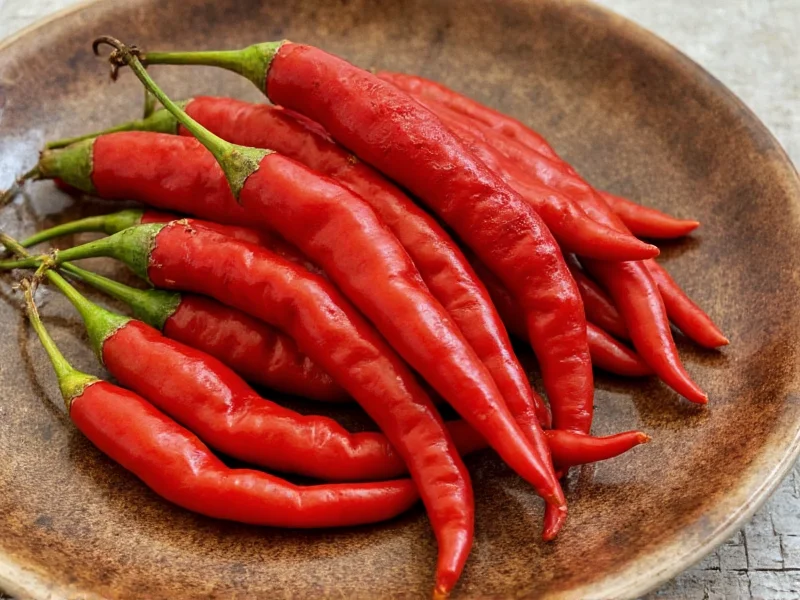These fiery little peppers pack a serious punch that defines much of Thailand's culinary identity. While their diminutive size might suggest mildness, Thai bird chiles rank among the hottest commonly used chilies in Asian cooking. Understanding their unique properties helps home cooks and chefs harness their power effectively without overwhelming dishes.
Physical Characteristics and Heat Profile
Thai bird chiles, known locally as prik kee noo (meaning "mouse droppings chili" due to their small size), display distinctive features that set them apart from other chili varieties. These peppers typically measure between 1-2 inches in length with a slender, tapered shape that often curves slightly. They mature from bright green to vibrant red, though some varieties may turn orange, yellow, or even purple when fully ripe.
Their heat level ranges from 50,000 to 100,000 Scoville Heat Units, placing them significantly hotter than jalapeños (2,500-8,000 SHU) but milder than the notorious ghost peppers (855,000-1,041,427 SHU). What makes Thai bird chiles special is their complex flavor profile—they deliver intense heat followed by subtle sweet, citrusy notes that enhance rather than dominate dishes.
Culinary Applications in Thai Cooking
Thai cuisine strategically employs bird chiles to create the essential balance of spicy, sour, sweet, and salty flavors. Chefs typically slice them thinly or crush them to release maximum flavor without making dishes overwhelmingly hot. In traditional preparations:
- Curries: Added early in cooking to infuse oil with heat
- Stir-fries: Tossed in during final minutes for fresh heat
- Nam prik (chili dips): Finely chopped for immediate fiery impact
- Tom yum soup: Used whole to gradually release heat
When working with these potent peppers, always remove seeds and membranes for milder heat. For authentic Thai flavor, use them fresh rather than dried, as drying intensifies their heat while diminishing their nuanced flavor profile.
Comparing Thai Bird Chiles to Other Varieties
| Chili Variety | Scoville Heat Units | Flavor Profile | Best Substitution Ratio |
|---|---|---|---|
| Thai Bird Chili | 50,000-100,000 | Intense heat with citrusy notes | 1:1 (reference) |
| Serrano | 10,000-23,000 | Grassy, bright heat | 2:1 |
| Habanero | 100,000-350,000 | Fruity, floral, very hot | 1:2 |
| Fresno | 2,500-10,000 | Mild, slightly sweet | 3:1 |
| Red Jalapeño | 2,500-8,000 | Grassy, moderate heat | 4:1 |
Practical Substitution Guide
Finding authentic Thai bird chiles can be challenging outside Southeast Asia. When substituting, consider both heat level and flavor characteristics. Serranos provide the closest fresh alternative, though they're significantly milder. Use two serranos for every Thai bird chili called for in a recipe. For dried applications, crushed red pepper flakes work in a 1:3 ratio but lack the distinctive citrus notes.
Many cooks mistakenly use cayenne peppers as substitutes, but this creates an entirely different flavor profile. Cayenne delivers consistent heat without the nuanced fruitiness of Thai bird chiles. For the most authentic experience when Thai bird chiles aren't available, combine serranos with a touch of citrus zest to approximate their distinctive flavor.
Growing Your Own Thai Bird Chiles
These compact plants thrive in containers, making them perfect for home cultivation. Start seeds indoors 8-10 weeks before last frost, maintaining soil temperature around 80-85°F (27-29°C) for optimal germination. Thai bird chili plants prefer:
- 6-8 hours of direct sunlight daily
- Well-draining soil with pH 6.0-6.8
- Consistent moisture (but not waterlogged soil)
- Temperatures between 70-85°F (21-29°C)
Most varieties mature in 70-80 days from transplanting. The plants typically reach 18-24 inches in height and produce abundant small peppers that start green and ripen to bright red. Harvest peppers when fully colored for maximum heat and flavor development.
Safety and Handling Best Practices
Working with Thai bird chiles requires caution due to their intense capsaicin content. Always follow these safety measures:
- Wear disposable gloves when handling
- Avoid touching face, especially eyes
- Use separate cutting boards for chilies
- Wash hands thoroughly with soapy water after handling
- If exposed to skin, use milk or oil to neutralize capsaicin
When cooking with these potent peppers, add them gradually and taste carefully. Remember that heat intensifies as dishes cook, so it's better to start with less and add more as needed. Never inhale steam from cooking chilies, as this can cause respiratory irritation.
Storage Methods for Maximum Freshness
Fresh Thai bird chiles maintain quality for 1-2 weeks when stored properly. For short-term storage, place unwashed peppers in a paper bag in the refrigerator's vegetable crisper. For longer preservation:
- Freezing: Spread whole peppers on a baking sheet, freeze until solid, then transfer to airtight containers (keeps 6-12 months)
- Drying: Hang in a warm, dry place or use a food dehydrator until brittle (creates intense heat for spice blends)
- Vinegar preservation: Submerge in rice vinegar for pickled chilies that mellow slightly while retaining heat
Never store fresh chilies in plastic bags, as trapped moisture accelerates spoilage. For immediate use, keep at room temperature for 2-3 days away from direct sunlight.











 浙公网安备
33010002000092号
浙公网安备
33010002000092号 浙B2-20120091-4
浙B2-20120091-4